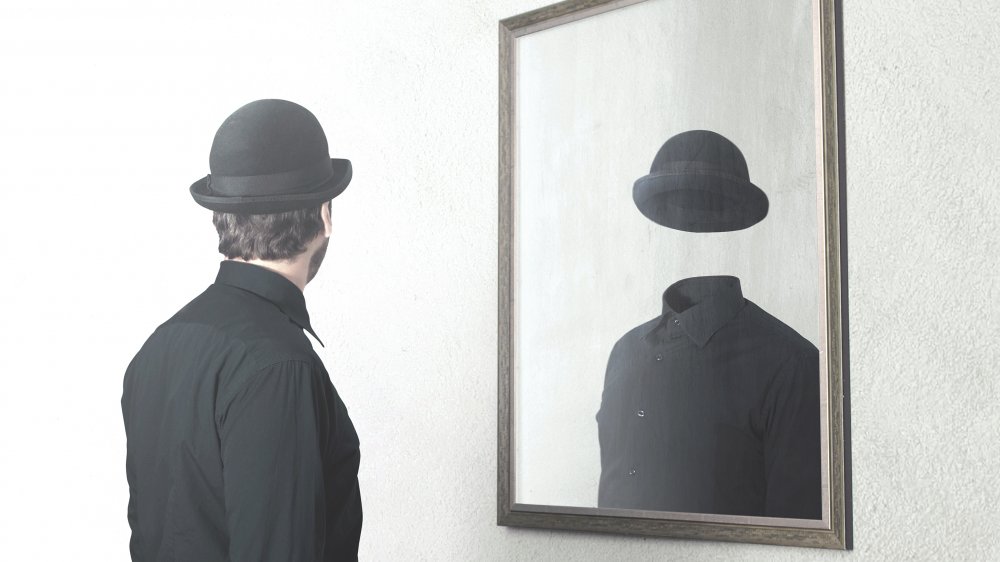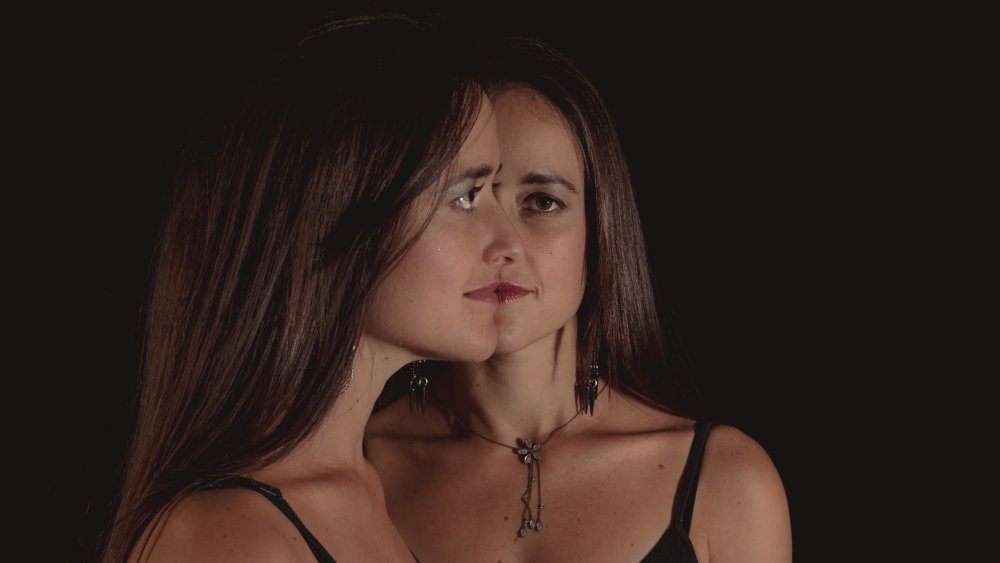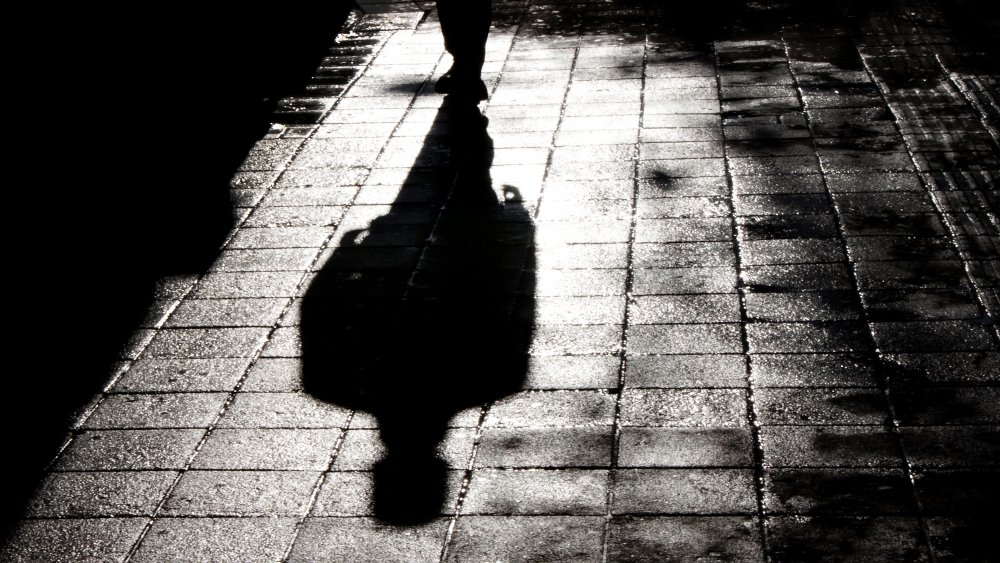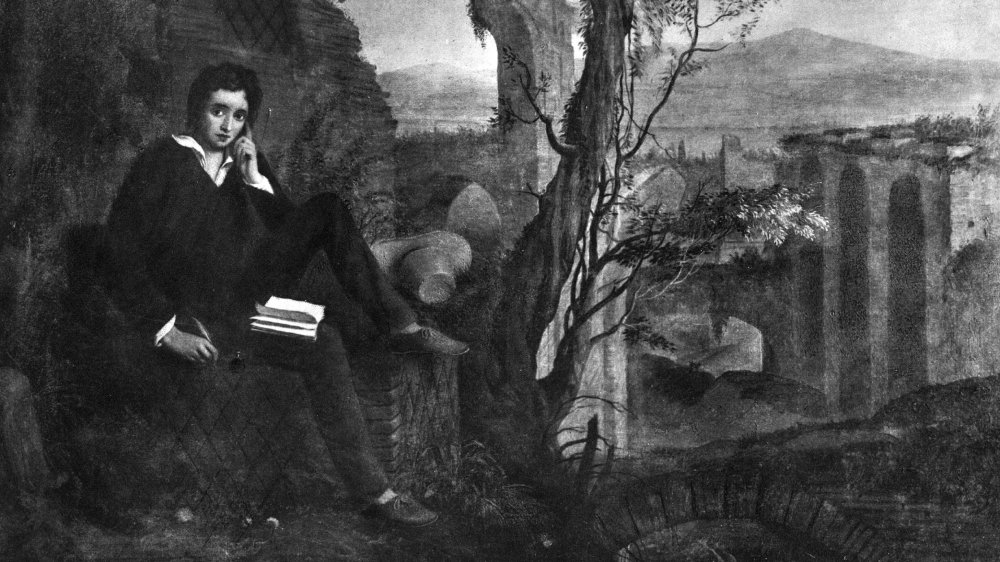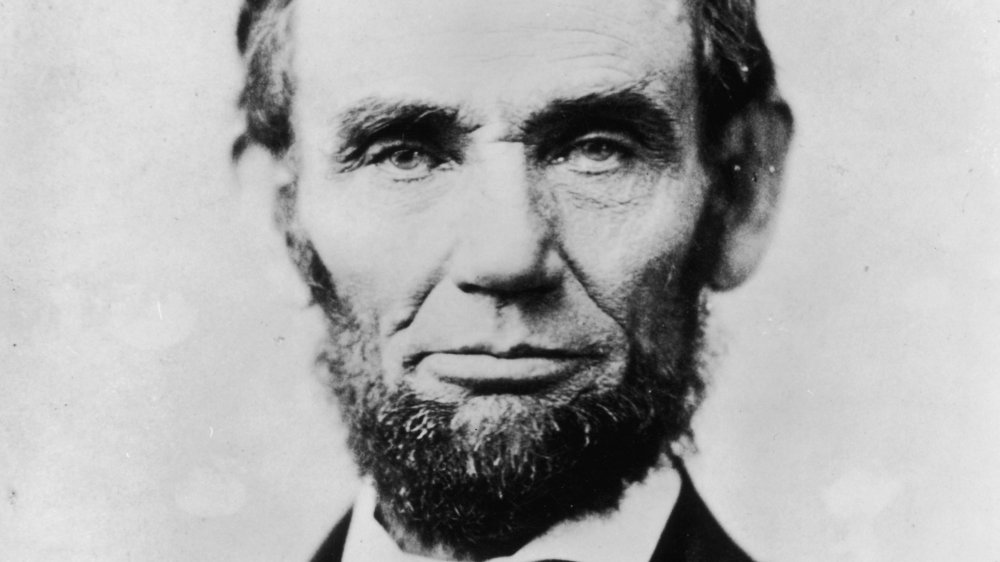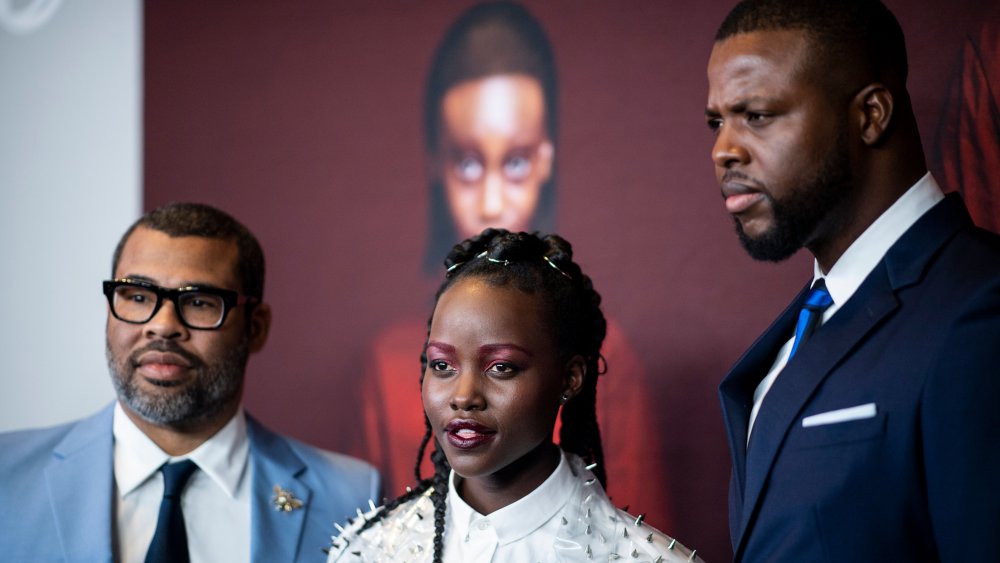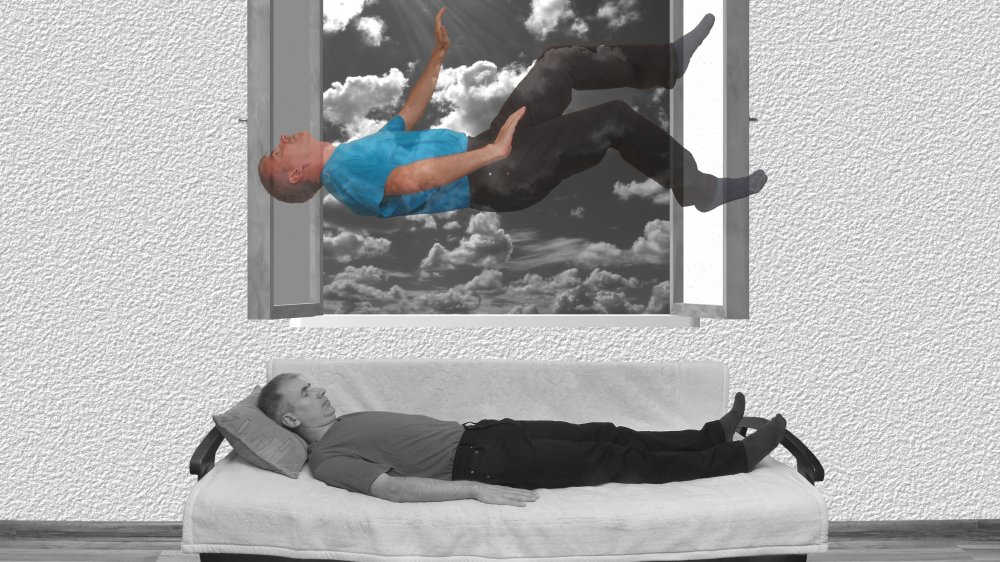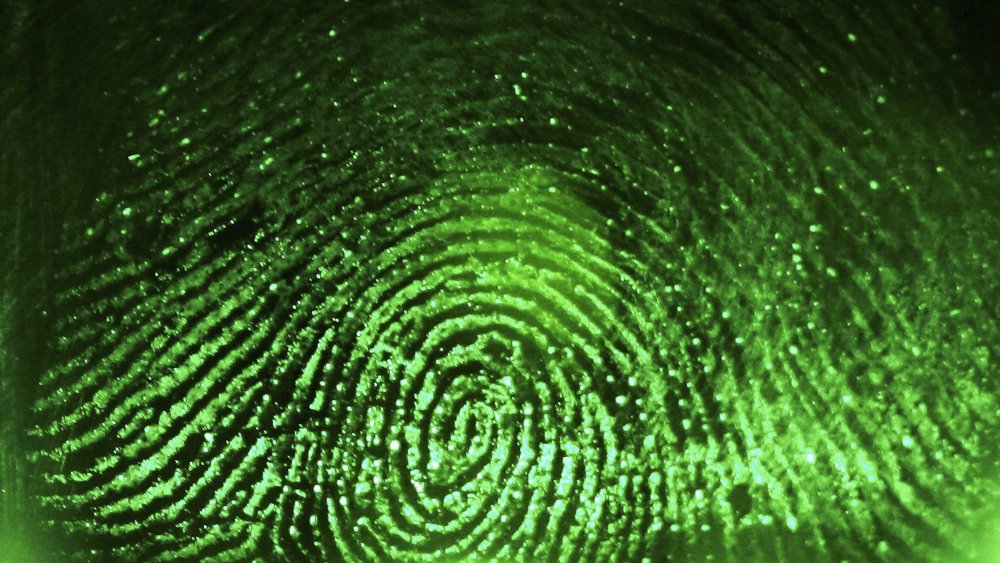The Legend Of Doppelgangers Explained
You are the only person who looks and acts like you, right? In theory, this is correct, but humans also have a long-standing fascination with the idea of another version of the self. What would you do if you found someone who looked just like you?
Look at legends about mirrors and how our reflection isn't just a reflection, but an actual copy of ourselves, living in a flipped universe to commit evil. Even Star Trek has its Mirror Universe where everyone has evil villain facial hair just to make sure you know they're up to no good.
Evil Spock aside, the legends of duplicated people go much further. What if, instead of a mirror universe, our exact copies could be found somewhere in the world today? What if there's someone out there who looks like you, talks like you, maybe even knows what you know? The idea we could be replaced by a copy is a frightening one. Here's the legend of doppelgangers explained.
A doppelganger is another you in another place
Ever wished you had an extra pair of hands to help you do stuff? Then the Germanic folklore of the doppelganger (technically "doppelgänger," but the umlaut can be dropped in English) is just what you need. A separate you that can sit in your classes and go to work while you sleep. Suddenly, you have a lot more free time, at least until you and your doppelganger start to argue over who has to do what and you inevitably add a second doppelganger to share the load and before you know it there are like 200 of you.
That's the dream, anyway. The actual myth is a lot more sinister, unfortunately. You see, a doppelganger isn't under your control and won't help you do chores. In fact, as pop culture has made clear over the years, your duplicate is out for one thing and one thing only: To do as much evil as possible while making you look responsible for it.
Put simply, a doppelganger is a duplicate of you of unknown origin that goes around and does terrible things, according to Bustle. Often, your doppelganger is seen by other people, but not by you personally. For example, say you get a phone call from your mom saying you were just on TV robbing a bank, but you were really in the bath the whole time. That's your doppelganger, trying to get you arrested to suit its evil needs.
Getting a head start
It is worth noting what a doppelganger is not, at this point. Let's say you go to the florist to buy flowers for your mom to apologize for the whole bank-robbing fiasco. You appear at the store, buy a dozen roses, and leave. Later, the florist sees you come in a second time and buy the same thing. Maybe they remark that you were just there or look familiar.
This is a specific Norse legend that is similar but distinct from the doppelganger, known as the vardøger. Instead of being a duplicate of you that goes around doing evil deeds on its own volition, the vardøger is sort of like reverse deja vu. It goes and does what you're going to do before you've actually done it and doesn't seem to have a will of its own, according to Norwegian Folktales.
It can be a little difficult to understand the differences, so here's an example you might have experienced yourself. Let's say you're at home and you hear your roommate at the door, but there's really no one there. Then, when your roommate does show up, you tell them this story, but they say it couldn't have been them because they were at a bank being robbed by your doppelganger. Vardøgers are duplicates, but they only do what you're going to do later, like a backwards echo.
The doppelganger as a portent of doom
One particular concern with a doppelganger is that they're typically considered a bad omen. While having someone spot your doppelganger, robbing a bank or otherwise, is bad enough, seeing your own doppelganger is supposed to be much worse. This is, according to folklore, a sign of very bad things coming your way. Like, a broken mirror crossing a black cat under a ladder kind of bad.
While doppelgangers can have a physical form, they can also be spotted in dreams or visions, and that's actually just as bad for your fortunes as a more tangible one. Dreams are how 19th century writer and poet Percy Shelley, husband of Frankenstein creator Mary Shelley, reportedly saw his own doppelganger on multiple occasions. He even briefly mentions meeting one's double in a garden in his drama Prometheus Unbound, allegedly an experience he himself had at one point, according to The Ghost of One's Self.
This final doppelganger sighting, the one that happened in real life, was on a terrace in Pisa, Italy in June of 1822, where his duplicate asked if he would ever be content. What's especially odd about this encounter is members of Shelley's house staff actually claimed to see the doppelganger that same day themselves. A few days later, Shelley set out on a sailing voyage, but never returned after his boat capsized and he died in July 1822.
Doppelgangers of the rich and famous
Percy Shelley wasn't the only famous historical figure to encounter their doppelganger, however. In 1612, English poet John Donne once claimed to see his wife's doppelganger carrying a dead child while he was staying in Paris, according to Atlas Obscura. Donne later discovered his wife had miscarried back home in England.
German writer Johann Wolfgang von Goethe told a particularly eerie story of encountering an older version of himself once while riding horseback down a road near his home in the 1770s. Several years later, he was travelling in the opposite direction and spotted a young version of himself wearing what he had worn that day, and to his surprise, realized he was wearing exactly what he had seen his older self wearing that day as well.
Even President Abraham Lincoln has been reported to have seen his doppelganger in the 1860s, shortly after he was elected to office, according to Bustle. He was looking into the mirror when a second, paler and more ghostly reflection of his face appeared next to his normal reflection, which he described as "two separate and distinct images." He tried to show his wife, Mary Todd Lincoln, but the reflection was gone. According to some tellings of this tale, which admittedly do sound pretty far-fetched, Mary Todd supposedly grew concerned and saw this as an ill omen that Lincoln wouldn't live to finish a second term.
The teacher's pet
One of the creepiest supposed doppelganger encounters wasn't just a single experience, but a long-term pattern of them. In 1845, a schoolteacher in Latvia named Emilie Sagée started at a new school and immediately encountered trouble when her students claimed that sometimes, while writing on the chalkboard or behind Sagée's back, a perfect copy of her would appear and mimic her movements or make insulting gestures at her, according to Vice. Reportedly, Sagée never actually saw the doppelganger herself, but her class saw it numerous times.
It wasn't just the students, either. School staff claimed to see her double walking around the school while the real Sagée was out in the garden, for example. While Sagée seemed to have no control over the doppelganger, it frightened students and school employees badly enough that she was eventually fired. The legends aren't clear whether the doppelganger continued to pester her or disappeared after she left the school, nor if she had problems with it before this particular school.
The tale does have some problems. Namely, the story came from Robert Dale Owen, a spiritualist who claimed to hear it secondhand from one of Sagée's students. While it's possible the story is somewhat true, in that Sagée might have existed and might have been fired from a school, there's no true evidence or firsthand accounts of the doppelganger, but it shows the kind of things people believe and expect of an evil double.
Double features at the movies
Doppelgangers are scary on an individual level, but they can also be scary on a societal level, which means they've been used in fiction and pop culture for centuries, according to the Hollywood Reporter. Often, these tales aren't just single doppelgangers, but entire large groups of them, because the idea of people you know and love being replaced by evil duplicates is pretty dang terrifying. Take, for example, 1978's Invasion of the Body Snatchers. While, on the surface, it seems like more of an alien invasion movie than a doppelganger movie, it definitely has those vibes. The extraterrestrials make evil copies of regular humans to slowly take over the world.
Jordan Peele's Us from 2019 is an even more direct doppelganger story (spoilers ahead!) because the movie's premise involves a family whose doppelgangers attack them, only for a mid-film twist to reveal that everyone's doppelgangers are attacking them because they've been living in underground tunnels for decades and are now taking over. (There are more surprises, too, so don't worry, the movie isn't ruined for you.)
Another example, with only a single doppelganger, is Arrival director Denis Villeneuve's 2013 film, Enemy, where a college professor named Adam discovers a man in a film, Anthony, who looks just like him. But while they look the same, they are very different, and the film plays with notions of identity and personality in very creepy ways.
What gängs around comes around
The term doppelgänger is, itself, a German word that, literally speaking, means double-goer or double-walker. But that particular term isn't as old as the legends of evil twins out to cause havoc for us. In fact, the origins of the word come from a single particular source, a novel written in 1796 by German author Jean Paul called Siebenkäs. He invented the word, originally spelled "doppeltgänger," for the story, according to Atlas Obscura.
The story isn't even paranormal at all. It's actually considered a comedic novel. In it, a man named Siebenkäs has a friend named Leibgeber and, for some unexplained reason, they look exactly identical. Siebenkäs is weary of his life, so Leigeber convinces him to fake his own death, at which point Leibgeber will take over as Siebenkäs. They do so, basically without consequence, which is kind of an anti-climactic resolution for a comedic novel these days, but hey, literature is weird.
What's more, in a later book by Paul, Titan, Siebenkäs returns and encounters what seems to be a third man who looks identical named Schoppe, according to The Doppelganger: Literature's Philosophy though it turns out to be Leibgeber using a name he presumably traded someone else for. Oddly, Schoppe/Leibgeber freaks out and drops dead when he sees Siebankäs because he thinks he's seeing a double of himself, but Schoppe/Leibgeber would presumably remember his old friend that looked just like him. Again, literature is weird.
A late start
Folklore and pop culture aside, let's say that one day, out of nowhere, you just so happen to see an exact duplicate of yourself. What then? This very thing happened to an anonymous patient being treated for seizures in Zurich in the 90s. According to the BBC, a PhD student named Peter Brugger was introduced to the man, who told him his bizarre story.
The patient woke up one day, felt dizzy, and turned around, at which point he saw himself still lying in bed. Thinking that this doppelganger was going to keep sleeping and make him late for work, the man began shouting at, and even jumping on, his duplicate. The version of himself in bed wouldn't wake up, though, and strangely, the man's perspective began shifting back and forth from the version of himself awake to the version of himself still in bed.
The confusion and fear from the situation caused the unnamed man to panic and jump out his own fourth-story window in hopes that it would somehow resolve the duplication. It did, but probably not in the way he expected. He survived and went to the hospital, where doctors found he had a brain tumor on his left temporal lobe. Removing the tumor not only resolved the issue with the doppelganger, but cleared up his seizures as well.
When the mirror comes to you
The experience of the anonymous patient is actually just one example of what science calls an autoscopic hallucination, which basically means you're hallucinating looking at yourself. While a brain tumor like this man's can certainly be the cause of that, it can be caused by other things too. For example, one of the most common types of autoscopic hallucinations is what's known as an out-of-body experience, which typically happens when a subject is near death, according to the BBC.
But for folks that are still very much alive, there's often another explanation, and it typically relates to seizures, just like with our anonymous patient. In another study where scientists were researching epilepsy sufferers, they found that if they applied a shock to a part of the brain called the right angular gyrus, the patient would often see another person in the room that they said looked just like them.
This seems to be related to a part of the brain called the temporo-parietal junction. With the right stimulus, it can cause us to hallucinate people who aren't there. This may be the very source of the legends of doppelgangers, and not anything paranormal at all. This same reaction in the brain might also explain many other phenomena out there, such as ghost sightings, imaginary friends, or the third man phenomenon, where mountain climbers and other isolated people will sometimes hallucinate a companion who isn't really there, according to NPR.
The digital doppelgangers of the 21st century
If you heard that a bit of folklore predicted a real problem that would emerge centuries later, then you'd probably roll your eyes and scoff. But in a lot of ways, it's completely true, and oddly gets truer still as time goes on. Doppelgangers exist today, but they aren't physical duplicates. They're virtual ones, like hackers, identity thieves, and other people who are up to no good. Somehow, an old Germanic legend has come to life for real in the 21st century.
As more of our identities become virtual and less physical, the threat grows stronger. Forty years ago, if someone wanted to appear to be you, they'd likely need a fake ID at least, maybe even some costumes and makeup. Now, it takes just moments for a bot to become nearly indistinguishable from the real you, log into your social media, and harass people in your name, according to Mentionmapp Analytics.
Not only that, but digital doppelgangers can now even learn about your likes and dislikes, how you act, and where you go online to make even more convincing fakes than ever before, according to Dark Reading. How is a site supposed to tell you apart from a hacker if you're both providing them with the exact same sets of data?
A doppelganger is one needle in an extremely large haystack
Okay, so actual, supernatural doppelgangers are (probably) not real. But what about identical twins? It's true that identical twins share DNA and usually look almost identical, but there are often tiny differences that go unnoticed by a regular person. One twin might be slightly taller, or have a different shade of hair or eye color.
It turns out that scientists have developed a way to measure those teeny tiny differences. So, let's say you took eight extremely precise facial measurements of yourself. What are the odds that someone could have those exact same measurements? The answer is one in a trillion, according to How Stuff Works. Since there are only about eight billion people alive right now, the odds aren't exactly great. There are memes out there showing the difference between a million and a billion, right? Take one of those and multiply the billion by 1,000, and that's the chances of an exact doppelganger of you.
It gets worse, though. If you include the full body, and not just the face, you are looking at a one in a quintillion chance of an exact duplicate of yourself existing by random genetic chance. That's a one followed by 18 zeros. So, simply put, it's not impossible, but the chances are so infinitely small that you're better off trying to develop cloning technology if you want to see your double any time soon.
A doppelganger is less like a photo, more like a sketch
So exact, precise doppelgangers are such a remote possibility that you don't really need to worry about that. However, there is one other possibility. They're not exact duplicates, and it relies on humans being, well, human. Basically, the human gene pool, despite thousands of years of mixing and mingling, is actually not all that diverse, especially when compared to other animals out there, according to Global News. Humans just really haven't been out there long enough to create all that many generations of diverse genetic material.
While the chances of your exact duplicate are essentially nil, there's a chance someone who is indistinguishable from you to the human eye does exist. That's how you end up with sites like Twin Strangers, which uses the power of the internet and A.I. to find people who look very much alike, or the work of photographer Francois Brunelle, who has found over 250 pairs of people who could be twins, but aren't.
Obviously, they're not exact duplicates. It's just that the vast majority of people aren't able to notice the subtle differences between them. If you look long enough, like a "spot the difference" picture, you can certainly find some, but at a quick look, humans just aren't that great at seeing the small details of someone's features.
